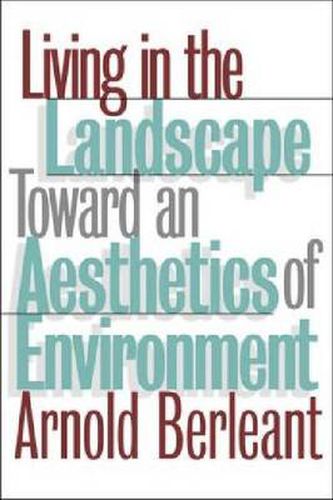Readings Newsletter
Become a Readings Member to make your shopping experience even easier.
Sign in or sign up for free!
You’re not far away from qualifying for FREE standard shipping within Australia
You’ve qualified for FREE standard shipping within Australia
The cart is loading…






This title is printed to order. This book may have been self-published. If so, we cannot guarantee the quality of the content. In the main most books will have gone through the editing process however some may not. We therefore suggest that you be aware of this before ordering this book. If in doubt check either the author or publisher’s details as we are unable to accept any returns unless they are faulty. Please contact us if you have any questions.
In Living in the Landscape Arnold Berleant explores new ways of thinking about how we live–and might live–in the landscapes that enfold us. Through the concepts of aesthetic engagement and environmental continuity, he proposes a new paradigm that offers a holistic approach to the meaning of place and places of meaning in our lives. Although environmental aesthetics is linked in the popular mind to dramatic vistas and monumental landscapes–the Grand Canyon, for example–Berleant is much more concerned with the commonplace settings of everyday life. He argues that our active appreciation of (or aesthetic engagement with) the prosaic landscapes of home, work, local travel, and recreation plays a vital role in our discovery of hidden continuities, as well as pleasure and meaning, in the places we inhabit.
Berleant begins with a general introduction to environmental aesthetics, identifying the kinds of experience, meanings, and values it involves, and describing its historical sources and the issues with which it is concerned. In the rest of the book, he spotlights new directions in the field–as they relate to education, community, creativity, and the sacred–and provides an insightful analysis of negative environmental aesthetics. Throughout, he is both thoughtful and entertaining, as evidenced in his extended critique of the pop post-modern environment of Disney World.
Berleant addresses issues commonly associated with the environmental movement–e.g., preservation, pollution control, and quality of life. But his study draws from a wide range of disciplines and for that reason should also appeal to scholars and students interested in art and aesthetics, landscape architecture and planning, urban and environmental design, and cultural geography, as well as environmental studies.
$9.00 standard shipping within Australia
FREE standard shipping within Australia for orders over $100.00
Express & International shipping calculated at checkout
Stock availability can be subject to change without notice. We recommend calling the shop or contacting our online team to check availability of low stock items. Please see our Shopping Online page for more details.
This title is printed to order. This book may have been self-published. If so, we cannot guarantee the quality of the content. In the main most books will have gone through the editing process however some may not. We therefore suggest that you be aware of this before ordering this book. If in doubt check either the author or publisher’s details as we are unable to accept any returns unless they are faulty. Please contact us if you have any questions.
In Living in the Landscape Arnold Berleant explores new ways of thinking about how we live–and might live–in the landscapes that enfold us. Through the concepts of aesthetic engagement and environmental continuity, he proposes a new paradigm that offers a holistic approach to the meaning of place and places of meaning in our lives. Although environmental aesthetics is linked in the popular mind to dramatic vistas and monumental landscapes–the Grand Canyon, for example–Berleant is much more concerned with the commonplace settings of everyday life. He argues that our active appreciation of (or aesthetic engagement with) the prosaic landscapes of home, work, local travel, and recreation plays a vital role in our discovery of hidden continuities, as well as pleasure and meaning, in the places we inhabit.
Berleant begins with a general introduction to environmental aesthetics, identifying the kinds of experience, meanings, and values it involves, and describing its historical sources and the issues with which it is concerned. In the rest of the book, he spotlights new directions in the field–as they relate to education, community, creativity, and the sacred–and provides an insightful analysis of negative environmental aesthetics. Throughout, he is both thoughtful and entertaining, as evidenced in his extended critique of the pop post-modern environment of Disney World.
Berleant addresses issues commonly associated with the environmental movement–e.g., preservation, pollution control, and quality of life. But his study draws from a wide range of disciplines and for that reason should also appeal to scholars and students interested in art and aesthetics, landscape architecture and planning, urban and environmental design, and cultural geography, as well as environmental studies.